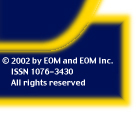| From the Publisher
By Roland Mangold Diary of an Alien in D.C.
"I'm an alien, I'm a resident alien, I'm a Canadian in D.C.," sung to the tune of "Englishman in New York," the song by the rock star, Sting.
This certainly seems like an alien place. Beyond one's first impressions of magnificent monuments, museums and government buildings and the unique, historic neighborhoods there is a malaise which appears to permeate throughout the city.
Mumblings and whispered conversations overheard on buses, trains and on the street all seem to have a similar overtone. The general theme is one of frustration with people's jobs. Not so much that they don't like their jobs. But, rather that their jobs aren't working - a frustration with the inefficiencies of their organizations. Now, when we consider that virtually everyone in DC either works for the Government, or works for a contractor to the Government. It makes me wonder how it works at all. Certainly, I would not contend that Canada runs more efficiently, that's one of the reasons I moved to Colorado ten years ago. But, the D.C. area does seem to be a "world on to itself."
In spite of the general malaise I sensed on the streets, this year's ASPRS Conference held in Washington D.C. was the most optimistic and up beat in years. There seem to be a number of factors that contribute to the excitement and optimism in the industry which was reflected at ASPRS. One major factor for this year's general enthusiasm is the fact that it was held in Washington DC. After all, this still is predominately a government centric business, what with the NIMA "Omnibus" contract and the USGS "down sizing" and "outsourcing" policies. These huge Government contracts have created a "first" tier of a handful of mapping and photogrammetry firms gearing-up for the, as yet unrealized, flood of mapping business expected from these outsourcing initiatives. This has also resulted in the establishment of dozens of "second" tier mapping firms (those who are not on the NIMA and USGS preferred list of vendors) who are vying for any overflow business from the first tier.
Interestingly, a number of the first tier firms have complained that the "Omnibus" business has not developed as quickly, or to the extent, that NIMA has led them to believe. And, that was after NIMA required the vendors to invest in increased capacity and conform to NIMA security procedures and facilities. As it turns out, it is actually the mapping companies' civilian and commercial work which is adding to their backlog and providing overflow work to the second tier. All this activity is resulting in the most bullishness the mapping sector has ever realized.
There was a bit of a dark cloud hanging over the ASPRS 2000 Conference, an example of how government does not work, which was not evident to the general attendee. I detected the odd whisper of complaint from some of the companies in attendance, and it was in reference to NASA's Commercial Remote Sensing Program (CRSP). It seems they have behaved no better than common street drug pushers in respect to their ill-conceived EOCAP program. Disguised as funding for cutting edge technology transfer or technology commercialization, it has turned out to be little more than corporate welfare. This funding which does not necessarily go to small indigent technology firms to help, or provide for, their R&D efforts. Big companies such as Boeing and Bechtel have also received funding through EOCAP.
But the worst cut of all is that after they get companies hooked on this "pork," recently, NASA has taken it away with no warning or reasonable explanation. This would be no big deal to companies such as Boeing and Bechtel - but to the small companies who have come to rely on Government hand outs, and have committed their limited and scarce resources to these projects - this is devastating.
Now, after canceling the EOCAP funding, CRSP has contracted a consulting firm to conduct market research to find out who is buying geospatial data? What are they buying? What will be their future need? And, these same consultants then come to me to get my opinion on who is buying what. After they get the information from me for free - they'll turn around and put it in a fancy report and charge NASA a ridiculous sum. Hey NASA, if your listening out there, why don't you just come straight to me? I'll give you all the information you need - no charge! Between EOM and The GEMI Store, we are in touch with more vendors and more users of geospatial information and data than anyone else. So far, we have been sharing this information, for no charge, with anyone who inquires. I consider it a part of my civic duty because as a Resident Alien I realize that to have the opportunity to live in the USA is a privilege, not a right.
Maybe NASA ought to get out of the commercialization business and stick to what it knows, like looking for aliens. Until next time,
Cheers!
 Roland Mangold
Publisher, Earth Observation Magazine
E-mail: [email protected] Back |




